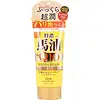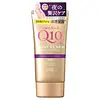What's inside
What's inside
 Key Ingredients
Key Ingredients

 Benefits
Benefits

 Concerns
Concerns

 Ingredients Side-by-side
Ingredients Side-by-side

Water
Skin ConditioningGlycerin
HumectantStearic Acid
CleansingCetyl Alcohol
EmollientEthylhexyl Palmitate
EmollientParaffinum Liquidum
EmollientPropanediol
SolventHorse Fat
Skin ConditioningNiacinamide
SmoothingUbiquinone
AntioxidantPersea Gratissima Oil
Skin ConditioningArgania Spinosa Kernel Oil
EmollientSqualane
EmollientHoney
HumectantSimmondsia Chinensis Seed Oil
EmollientLactobacillus/Soymilk Ferment Filtrate
Skin ConditioningPlacental Extract
Sh-Barley Seed Extract
Skin ConditioningHydrogenated Lecithin
EmulsifyingBehenyl Alcohol
EmollientPolysorbate 60
EmulsifyingSorbitan Stearate
EmulsifyingPhenoxyethanol
PreservativeMethylparaben
PreservativePotassium Hydroxide
BufferingTrisodium EDTA
Propylparaben
PreservativeButylene Glycol
Humectant1,2-Hexanediol
Skin ConditioningDimethicone
EmollientUrea
BufferingParfum
MaskingWater, Glycerin, Stearic Acid, Cetyl Alcohol, Ethylhexyl Palmitate, Paraffinum Liquidum, Propanediol, Horse Fat, Niacinamide, Ubiquinone, Persea Gratissima Oil, Argania Spinosa Kernel Oil, Squalane, Honey, Simmondsia Chinensis Seed Oil, Lactobacillus/Soymilk Ferment Filtrate, Placental Extract, Sh-Barley Seed Extract, Hydrogenated Lecithin, Behenyl Alcohol, Polysorbate 60, Sorbitan Stearate, Phenoxyethanol, Methylparaben, Potassium Hydroxide, Trisodium EDTA, Propylparaben, Butylene Glycol, 1,2-Hexanediol, Dimethicone, Urea, Parfum
Water
Skin ConditioningButylene Glycol
HumectantGlycerin
HumectantTriethylhexanoin
MaskingCetearyl Alcohol
EmollientDipropylene Glycol
HumectantBehenyl Alcohol
EmollientPetrolatum
EmollientParaffinum Liquidum
EmollientHydrogenated Rapeseed Glycerides
EmulsifyingLimnanthes Alba Seed Oil
Skin ConditioningPrunus Amygdalus Dulcis Oil
Skin ConditioningOlea Europaea Fruit Oil
MaskingGlycosyl Trehalose
Emulsion StabilisingTocopherol
AntioxidantPanthenol
Skin ConditioningSodium Hyaluronate
HumectantSimmondsia Chinensis Seed Oil
EmollientUbiquinone
AntioxidantHydrolyzed Collagen
EmollientDisodium EDTA
Acrylates/C10-30 Alkyl Acrylate Crosspolymer
Emulsion StabilisingCarrageenan
Agar
MaskingXanthan Gum
EmulsifyingDimethicone
EmollientSodium Methyl Stearoyl Taurate
CleansingSorbitan Palmitate
EmulsifyingStearic Acid
CleansingPolysorbate 80
EmulsifyingDiisostearyl Malate
EmollientHydrogenated Starch Hydrolysate
HumectantSodium Hydroxide
BufferingPhenoxyethanol
PreservativeMethylparaben
PreservativeParfum
MaskingCaramel
Cosmetic ColorantCI 77492
Cosmetic ColorantWater, Butylene Glycol, Glycerin, Triethylhexanoin, Cetearyl Alcohol, Dipropylene Glycol, Behenyl Alcohol, Petrolatum, Paraffinum Liquidum, Hydrogenated Rapeseed Glycerides, Limnanthes Alba Seed Oil, Prunus Amygdalus Dulcis Oil, Olea Europaea Fruit Oil, Glycosyl Trehalose, Tocopherol, Panthenol, Sodium Hyaluronate, Simmondsia Chinensis Seed Oil, Ubiquinone, Hydrolyzed Collagen, Disodium EDTA, Acrylates/C10-30 Alkyl Acrylate Crosspolymer, Carrageenan, Agar, Xanthan Gum, Dimethicone, Sodium Methyl Stearoyl Taurate, Sorbitan Palmitate, Stearic Acid, Polysorbate 80, Diisostearyl Malate, Hydrogenated Starch Hydrolysate, Sodium Hydroxide, Phenoxyethanol, Methylparaben, Parfum, Caramel, CI 77492
 Reviews
Reviews

Ingredients Explained
These ingredients are found in both products.
Ingredients higher up in an ingredient list are typically present in a larger amount.
Behenyl Alcohol is a type of fatty alcohol (these are different from the drying, solvent alcohols).
Fatty Alcohols have hydrating properties and are most often used as an emollient or to thicken a product. They are usually derived from natural fats and oils; behenyl alcohol is derived from the fats of vegetable oils.
Emollients help keep your skin soft and hydrated by creating a film that traps moisture in.
In 2000, Behenyl Alcohol was approved by the US as medicine to reduce the duration of cold sores.
Learn more about Behenyl AlcoholButylene Glycol (or BG) is used within cosmetic products for a few different reasons:
Overall, Butylene Glycol is a safe and well-rounded ingredient that works well with other ingredients.
Though this ingredient works well with most skin types, some people with sensitive skin may experience a reaction such as allergic rashes, closed comedones, or itchiness.
Learn more about Butylene GlycolDimethicone is a type of synthetic silicone created from natural materials such as quartz.
What it does:
Dimethicone comes in different viscosities:
Depending on the viscosity, dimethicone has different properties.
Ingredients lists don't always show which type is used, so we recommend reaching out to the brand if you have questions about the viscosity.
This ingredient is unlikely to cause irritation because it does not get absorbed into skin. However, people with silicone allergies should be careful about using this ingredient.
Note: Dimethicone may contribute to pilling. This is because it is not oil or water soluble, so pilling may occur when layered with products. When mixed with heavy oils in a formula, the outcome is also quite greasy.
Learn more about DimethiconeGlycerin is already naturally found in your skin. It helps moisturize and protect your skin.
A study from 2016 found glycerin to be more effective as a humectant than AHAs and hyaluronic acid.
As a humectant, it helps the skin stay hydrated by pulling moisture to your skin. The low molecular weight of glycerin allows it to pull moisture into the deeper layers of your skin.
Hydrated skin improves your skin barrier; Your skin barrier helps protect against irritants and bacteria.
Glycerin has also been found to have antimicrobial and antiviral properties. Due to these properties, glycerin is often used in wound and burn treatments.
In cosmetics, glycerin is usually derived from plants such as soybean or palm. However, it can also be sourced from animals, such as tallow or animal fat.
This ingredient is organic, colorless, odorless, and non-toxic.
Glycerin is the name for this ingredient in American English. British English uses Glycerol/Glycerine.
Learn more about GlycerinMethylparaben is a preservative and is a paraben. It is used to prevent the growth of fungus, mold, and other harmful bacteria. Parabens are chemicals used as preservatives in both cosmetics and food.
Methylparaben can be synthetically created. It can also be found naturally in some fruits, such as blueberries.
Oftentimes, Methylparaben is combined with other parabens to help increase the shelf life.
The safety of Methylparaben is currently being studied. While ongoing studies are looking into the safety of parabens, the results have been very mixed. Some studies have not found Methylparaben to be harmful.
Learn more about MethylparabenParaffinum Liquidum is also known as liquid paraffin. It is a type of highly refined mineral oil.
Like other oils, Paraffinum Liquidum has emollient properties. Emollients help soothe and soften the skin. By creating a barrier to trap moisture within, emollients help keep your skin hydrated.
Paraffinum Liquidum does not irritate the skin and is non-comedogenic.
Learn more about Paraffinum LiquidumParfum is a catch-all term for an ingredient or more that is used to give a scent to products.
Also called "fragrance", this ingredient can be a blend of hundreds of chemicals or plant oils. This means every product with "fragrance" or "parfum" in the ingredients list is a different mixture.
For instance, Habanolide is a proprietary trade name for a specific aroma chemical. When used as a fragrance ingredient in cosmetics, most aroma chemicals fall under the broad labeling category of “FRAGRANCE” or “PARFUM” according to EU and US regulations.
The term 'parfum' or 'fragrance' is not regulated in many countries. In many cases, it is up to the brand to define this term.
For instance, many brands choose to label themselves as "fragrance-free" because they are not using synthetic fragrances. However, their products may still contain ingredients such as essential oils that are considered a fragrance by INCI standards.
One example is Calendula flower extract. Calendula is an essential oil that still imparts a scent or 'fragrance'.
Depending on the blend, the ingredients in the mixture can cause allergies and sensitivities on the skin. Some ingredients that are known EU allergens include linalool and citronellol.
Parfum can also be used to mask or cover an unpleasant scent.
The bottom line is: not all fragrances/parfum/ingredients are created equally. If you are worried about fragrances, we recommend taking a closer look at an ingredient. And of course, we always recommend speaking with a professional.
Learn more about ParfumPhenoxyethanol is a preservative that has germicide, antimicrobial, and aromatic properties. Studies show that phenoxyethanol can prevent microbial growth. By itself, it has a scent that is similar to that of a rose.
It's often used in formulations along with Caprylyl Glycol to preserve the shelf life of products.
This oil comes from the seeds of the desert shrub called Jojoba. It is more commonly known as jojoba oil, a non-comedogenic oil.
Jojoba oil does not contain fragrance and has many fatty-acids, making it a great soothing ingredient.
It also contains Vitamin E, a great moisturizing ingredient. Vitamin E is also an antioxidant and protects your skin against oxidative damage.
This ingredient humectant properties, meaning it helps draw moisture from the air. This helps keep your skin hydrated.
While jojoba has antibacterial properties, it is only able to kill some strains of bacteria.
Studies also show it helps in wound healing. In fact, Indigenous cultures have used jojoba as a moisturizer and to help treat burns for centuries.
Fun fact: Jojoba oil similar to natural human skin sebum, so it has a great effect on dry skin. It is also promising with helping to regulate sebum production.
Due to its fatty acid content, Jojoba oil may not be fungal acne safe. We recommend speaking with a professional if you have any concerns.
Learn more about Simmondsia Chinensis Seed OilStearic Acid is a fatty acid. It is an emollient, emulsifier, and texture enhancer.
As an emollient, stearic acid helps soften skin. It aids the skin's protective barrier by preventing water loss. It also provides a gentle cleansing effect without stripping away natural oils.
Stearic acid may also be used to enhance the texture of products. It can add volume and stabilize ingredients such as water and oil. This can help water and oil ingredients from separating.
Sources of stearic acid include animal or vegetable fats/oils such as coconut or shea. It can be naturally found in butter, cocoa butter, shea butter, vegetable fats, and animal tallow.
This ingredient may not be Malassezia folliculitis, or fungal-acne safe.
Learn more about Stearic AcidUbiquinone (Coenzyme Q10) is a molecule already found in our bodies. It is a potent antioxidant and skin-soothing ingredient.
Aging and environmental exposure diminishes our skin's natural ubiquinone levels. This is much like our natural collagen and elastin.
The good news is: studies show applying this ingredient topically replenishes ubiquinone levels in our skin. This also comes with a ton of skin benefits. These benefits include:
Ubiquinone is considered a large molecule and cannot be absorbed into the lower layers of skin. This is why it is believed to be such an effective antioxidant: it protects our skin in the upper layers and prevents damage in the deeper layers.
When used in sunscreen, ubiquinone is shown to increase ingredient stability, increase SPF factor, and add to infrared protection.
Fun fact: ubiquinone is fat-soluble.
Learn more about UbiquinoneWater. It's the most common cosmetic ingredient of all. You'll usually see it at the top of ingredient lists, meaning that it makes up the largest part of the product.
So why is it so popular? Water most often acts as a solvent - this means that it helps dissolve other ingredients into the formulation.
You'll also recognize water as that liquid we all need to stay alive. If you see this, drink a glass of water. Stay hydrated!
Learn more about Water